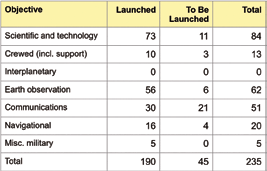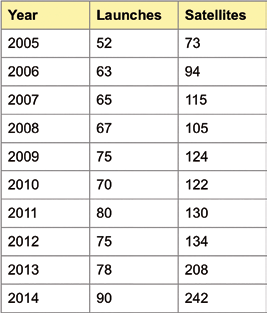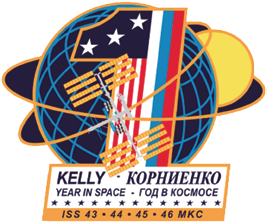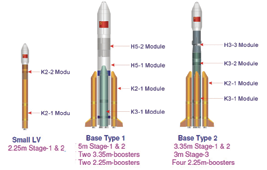The Heyman Report
By Jos Heyman, Senior Contributor

Last year at this time, this author predicted there would be 238 satellites placed in orbit by 83 launches.
How wrong ‘your’s truly’ was, as the actual number turned out to be 242 satellites with 90 launch vehicles. This is the unfortunate result of having to write an article two months before the year is over as well as China launching six unannounced satellites on three equally unannounced launch vehicles and Japan placing four secondary payloads on a launch vehicle. Add to that the Russians launching the Angara 5 rocket, and you can see the difficulty one faces.
Having said that, and keeping in mind potentially similar events towards the end of 2015, at the time of this writing, the prediction is that there will be 235 spacecraft launched via 85 launches. This tally does not include the maximum of 87 small satellites that could be have been launched as secondary payloads with a Falcon 9 launch vehicle. Originally slated for late December 2015, this batch has now been rescheduled for early 2016. These satellites will be deployed with a Sherpa space tug.
As to the purpose of these satellites, the Table 2 provides a break-down. This total includes a number of the cubesats that were already on ISS as of January 1, 2015, but which had not yet been deployed on that date.

ISS
The International Space Station was certainly in the news this year.
Russia announced that it had committed itself to take part in the ISS program until 2024. After that it intends to detach the Russian modules and establish its own space station in low-Earth orbit. The new space station would be completed by 2028 and will be used as a base for lunar exploration, including crewed lunar missions by 2030.
During the year two re-supply missions to the ISS failed. Progress M-27M had to be abandoned in low-orbit after its launch on 28 April 2015, whilst the Dragon CRS-7 failed to orbit on 28 June 2015.
The latter spacecraft was expected to dock with the nadir port of the Harmony module of ISS on 30 June 2015 and 1952 kg of supplies internally, including more than 35 experiment for ISS and eight Flock 1f Earth observation satellite. It also carried externally the first International Docking Adapter (IDA) that was to be installed on PMA-2 to establish the first docking port on ISS that could be used by future Commercial Crew Vehicles.
The failure posed no difficulty to the day-to-day operations on ISS or the supplies on board of ISS. Apart from Progress M-28M, that was launched on July 3, 2015, and the Japanese HTV-5 cargo spacecraft on August 19, 2015. There were a further two Progress flights whilst the Cygnus Orb-4 is expected to be launched in December 2015, although this launch might be brought forward.
In the meantime, Scott Kelly and Mikhail Kornienko are the two crew members on the space station that are on a one year expedition that started on March 27, 2015 and will last until March 2016.
The RD-180 Saga + A Bit More
The RD-180 rocket engine that powers the first stage of the Atlas 5 launch vehicle was developed over a 42 months period during the early 1990s. The engine was originally developed by the Yuzhnoye Design Office in Ukraine, at a time that Ukraine was still part of the USSR. Ultimately the production moved to Energomash, a Russian undertaking.

Being a two-thrust-chamber derivative of the four-chamber RD-170 rocket engine used on the Zenit launch vehicle and using 80% of the RD-170 parts, the RD-180 was developed at the fraction of the cost of a typical US new engine development. Since its adoption by the US, the RD-180 has been used for the six Atlas III launch vehicles as well as over 60 Atlas 5 launch vehicles.
Following the separation of the Crimea from Ukraine in early 2014, a separation supported by Russia, the US Congress has passed a law that prohibits the US Air Force to have launch service providers use launch vehicles fitted with Russian made rocket engines for military launches from 2019 onwards.
Two companies have undertaken the development of a RD-180 replacement rocket engine. These are the Blue Origin’s BE-4, which will be fueled by liquid natural gas, and the Aerojet-Rocketdyne’s AR-1, which will be fueled by kerosene, like the RD-180.
The BE-4 is the furthest developed and is expected to fly for the first time in 2019, but its different fuel requires an adaptation of the Atlas core stage. The AR-1 does not have that problem but indications are it will not be ready by 2019.

To make matter more complicated, the Yuzhnoye State Design Office of Dnepropetrovsk, Ukraine, is offering its own RD-180 replacement in the form of two clustered GU250 rocket engines. The engine is capable of throttling and utilizes the same LOX-rich staged combustion technology employed in the RD-180. Development of critical components and units of this engine is currently underway and Yuzhnoye would like to establish production facilities in the US.
The US Air Force has indicated that these replacement engines either need a new launch vehicle or major modifications to the Atlas 5, something that may take some further years before the new/modified launch vehicles are certified for use on national security flights, indicating the replacement might not be available until 2022.
In the meantime launch provider ULA has a small stock of RD-180 rocket engines that is sufficient to keep the Atlas 5 flying until 2017. Subsequently the US Air Force and ULA want the ban lifted to fill that gap by allowing ULA to buy another 22 RD-180s, something that is opposed by the Senate Armed Services Committee Chairman Sen. John McCain.
The additional engines would allow ULA to effectively bid for nine national security launches all of which would be suitable for the Atlas 5. In addition another 28 missions will be put up for bids in 2018, of which 25 are suited for the Atlas 5.
Somehow related to the above and, in what seems to be a clear case of politics and lobbying, a group of 17 members of Congress, all Republican and more than half of them representing states where United Launch Alliance (ULA) and its business partners are operating, have questioned the adequacy of SpaceX’s investigation into the 28 June 2015 failure of a Falcon 9 launch vehicle. They also questioned whether SpaceX can be trusted with the critical military and intelligence payloads it wants to launch and wanted to know how tough NASA and the US Air Force are getting with SpaceX.
How this saga will eventually end is anybody’s guess but it does, in this author’s opinion, point at severe shortcomings of all those involved – shortcomings that they should resolve by dropping political grand standing, adopting non-competitive cooperative approaches and improving bureaucratic procedures.
An interesting aspect is that the purchase of 60 RD-181 rocket engines by Orbital ATK for its Antares launch vehicle, is not subject to the above restrictions because the Antares is not intended for national security satellite launches.

New Launch Vehicles
ULA also unveiled its new launch vehicle during the year. Previously referred to as the Next Generation Launch System (NGLS) it has now been named Vulcan. The Vulcan will gradually replace the Atlas 5 and Delta 4 launch vehicles, commencing with a planned 2019 first flight.
The core or first stage of the Vulcan will be powered by either two Blue Origin BE-4 liquefied natural gas main engines or two Aerojet Rocketdyne AR-1 kerosene power plants, depending on a choice to be made next year.
Like the Atlas 5 and Delta 4 launch vehicles, the use of different nose cones and up to six strap-on boosters, will allow the Vulcan to be optimized for a specific payload requirement, thereby servicing the full spectrum of launch requirements.
The launch cost of the Vulcan is expected to reduce from the current $164 million for an Atlas 5 launch, to $100 million for the basic Vulcan.
ULA plans to replace the current Centaur upper stage with a new upper stage by 2023. Known as the Advanced Cryogenic Evolved Stage (ACES) this stage will be powerful enough to place the heaviest satellites directly into a geostationary orbit.
Further down the track, in 2024, ULA hopes to introduce the recovery of the first stage engines through the Sensible Modular Autonomous Return Technology process in which the two first stage engines would separate from the tank after burn-out and then deploy an inflatable heat shield to slow their re-entry. Next steerable parachutes would be deployed which would slow their descent for mid-air recovery by a helicopter.
The engines would then be re-certified and used again.
China undertook the first launch of the Chang Zheng (CZ) 6 launch vehicle on 19 September 2015 and the CZ 11 launch vehicle on 24 September 2015. Both these launch vehicles represent a change in rocket technology from toxic propellant combinations to environmentally friendly propellants and solid propellant, technologies that will also find their way to the future CZ 5 and CZ 7 launch vehicles.
CZ 6 is intended as a light capacity high response launch vehicle that will have a capability to placer 16500 kg into a LEO and 1080 kg into a sun-synchronous orbit. The first stage is powered by a K2-1 (YF-100) liquid fueled rocket engine whereas the second stage has a K2-2 (YF-115) liquid fueled rocket engine. The launch vehicle was developed by the China Aerospace Science and Technology Corporation and the China Academy of Launch Vehicle Technology. Through the use of a variety of boosters and an upper stage the launch vehicle can be expanded.
CZ 11 is a four stage launch vehicle with three solid fueled stages and a
YF-50 powered fourth stage referred to as the Auxiliary Liquid Fueled Upper Module, designed for precise orbit insertion. Having a length of 18.7 m and a diameter of 2.0 for the first stage and a payload fairing with a diameter of 1.6 m, the launch vehicle is optimized for small payloads and is believed to have a capability of 1000 kg into a Sun-synchronous orbit.
On February 11, 2015, ESA’s Intermediate eXperimental Vehicle (IXV), a lifting-body re-entry experiment to validate re-entry technologies for future European reusable launchers, was released from the Vega launch vehicle at 320 km altitude and reached an altitude of 420 km after about 32 minutes. From here the 480 kg vehicle descended reaching a speed of 27,000 km/h, before at an altitude of 120 km and 64 minutes into the flight, its aerodynamic shape, thrusters and two tail flaps, lead it towards a splash down suspended from parachutes into the Pacific Ocean after a flight of 1 hour, 39 min. During the descent it made measurements that will be used in the development of future re-entry vehicles.
The launch was originally scheduled for mid-November 2014 but was delayed in late October 2014 after the French space agency, CNES, and ESA determined that the flight trajectory of the Vega rocket would have posed unacceptable risks to people in French Guiana. Although the intended flight path had been known for years, the ESA IXV team and CNES had failed to assess the potential risk. Subsequently an alternative trajectory was selected in which the flight path at lift-off was modified by 3o to the north after which the Vega rocket performed a dogleg maneuver to get back to the original intended flight path.
New Launch Sites
Plans for the future have involved the selection of a few new launch sites. Rocket Lab Ltd., the US-New Zealand company that is developing the Electron small launch vehicle, has selected Kaitorete Spit, a narrow strip of land between a Lake Ellesmere and the Pacific Ocean on New Zealand’s South Island, as the launch site. By selecting its own site, the company intends to avoid the launch scheduling conflicts that exist on other multi-user sites. Rocket Lab expected the first launch to take place before the end of this year whilst, once fully operational, they expect weekly launches.
The location has previously been used for NASA sounding rockets as well as amateur rockets and launches would be flying south in orbits with an inclination ranging from 45o to sun-synchronous. Rocket Lab will be building its own infrastructure comprising the launch pad, a vehicle transporter and erector, fuel tanks, and a hangar.
Houston Airport Systems intends to develop Ellington Airport in Texas, as a licensed commercial spaceport for future reusable launch vehicles. Long term this could mean the transformation of the airport into a space hub where spacecraft would be manufactured, astronauts be trained and microsatellites could be launched. Ellington Airport is located south of the city and was originally established as a military airbase before it became one of the airports extensively used by NASA. Its location is close to the Johnson Space Centre.
China is in the progress of establishing the Wenchang Satellite Launch Center (WSLC). Located in Wenchang, Hainan, China, is a former sub-orbital test center. It will become China’s fourth and southernmost space vehicle launch facility (spaceport) and has been specially selected for its low latitude, which is only 19 degrees north of the equator. This will allow a substantial increase in payload, necessary for the future manned program, space station and deep space exploration program. Furthermore, it will be capable of launching the new heavy lift CZ 5 launch vehicle currently under development.
Russian Space Expansions
In addition to the country’s intention to establish a new space station, as referred to above, Russia announced some ambitious space plans during the year. Roscosmos hopes to expand the fleet of Earth Observation (EO) satellites to about 20 as part of a project aiming at Russia becoming a major player in the delivery of remote sensing services. The current fleet will be expanded by a Resurs-P satellite later this year and four Obzor-O satellites in early 2016.
Russia also hopes to place a lander on the south pole of the Moon in 2019. It has been suggested that this spacecraft will be named Luna-25. Russia is also courting China for joint manned space missions, including to the Moon, as well as synchronizing mutual hardware platforms and technological interfaces.
However, the various failures during the past few years have also initiated a review and restructuring process of the Russian space industry, with indications that a more centralized approach will be taken, not unlike that during the Soviet Union era.
Large Constellations —Large Undertakings—Large Risks
This was the year of proposals for large constellations in space. Here are some of them. It is unlikely that all will survive, considering the risks they are facing in attracting funds as well as the competition by other, similar proposals. In addition, there is the risk of failing to attract the customers for these ambitious undertakings.
San Francisco based company Spire, formerly known as NanoSatisfi Inc., intends to establish a constellation consisting of up to 100 cubesats to provide data on weather and climate changes on a global basis. The satellites will be fitted with High Resolution Sensors that measure the GPS signals through Earth’s atmosphere to calculate temperature, pressure, and humidity with a high accuracy and resolution. The expectation is that the satellite constellation will be upgraded every two years to keep pace with changing technology. Once operational the system is expected to provide five times more data than current systems provide by the end of 2015, 10 times by the end of 2016, and more than 100 times the data by the end of 2017.
BlackSky Global intends to establish a constellation of 60 satellites to provide one-meter resolution optical images. Operating from an altitude of 450 km, each 50 kg satellite, will remain in orbit for about three years, requiring a constant replenishment of the constellation although this will also allow incorporation of improved technology. The launch of the first two BlackSky satellites was planned for December of 2015 as part of the many small satellites to be carried on a Spaceflight Services Sherpa tug. Another four will follow in 2016 allowing the operations to start.
Leosat is a proposed constellation of 80 to 120 HTS in LEO. The services to be provided are not intended for general use but will, instead, concentrate on selected customers and provide them with solutions to communications problems that are currently not being met. Launches are expected to commence in 2019 or 2020.
Outernet is a project funded by the Media Development Investment Fund (MDIF) of New York to establish a network of 200 cubesats to transmit one way Internet signals to provide news to users.
On October 7, 2015, China launched the first four Jilin EO satellites in a constellation that is expected to reach 60 by 2020, giving it a capability to capture images of any point on Earth every 30 minutes. By 2030, the constellation is expected to have 138 satellites with a 10 minute image refresh capability.
Then, there is OneWeb, a proposed constellation of 900 Internet broadcasting satellites. The satellites will be built by Airbus Defence and Space and the company, which up to now has built large, one-off satellites, will have to upgrade its satellite manufacturing approach to complete as many as o four satellites a day. The bulk of the satellites will be built in a US-based facility. The individual satellites will have a mass of 150 kg each and 648 of them will be placed in 20 orbital planes with an altitude of about 1200 km. The remaining satellites will be used as spares on the ground or in orbit.
The bulk of the OneWeb satellites will be launched with 21 Soyuz launch vehicles that will be provided by Arianespace. The first launch is expected to occur in late 2017 and will carry only 10 satellites. Subsequent launches will each carry 32 to 36 satellites, depending on the mass of the satellite. Launches should be completed by the end of 2019. In addition OneWeb has an option for another five Soyuz flights and three Ariane 6 flights.
To fill gaps in the overall constellation, OneWeb has also entered into a contract with Virgin Galactic for 39 launches via the company’s LauncherOne to place a maximum of three OneWeb satellites in orbit on each flight. These flights will occur over a period of five years. OneWeb also has an option for another 100 launches.
To boost the chances of success for OneWeb, Intelsat has decided to invest $25 million in this undertaking, in return for which Intelsat will receive exclusive distribution rights for aeronautical and maritime markets, major US government sectors, the O&G industry and cellular backhaul accounts, as well as certain exclusive distribution rights for connected cars. OneWeb has also agreed to integrate Intelsat’s Epic Ku-band high-throughput capacity with OneWeb’s constellation, a move that gives OneWeb early access to its future markets using the Intelsat Epic satellites.
To top it all off, SpaceX has proposed to establish a global satellite based Internet network that will include some 4,000 satellites in LEO. The system has not been named as of yet—the only documentation yet seen was submitted to the International Telecommunication Union (ITU), the Geneva-based United Nations agency that regulates orbital slots and the radio spectrum. The satellites would operate at an altitude of 1100 km and initial services in the Ku- and Ka-band could start within five years.
Without doubt, the highlight of the year was the fly-by of Pluto by the New Horizons spacecraft that took place in July. The images that were sent back to Earth reveal icy plains with intriguing irregular features and evidence of active land-forming processes, while there is also a tail of ionized plasma dragging behind Pluto created by a gradual loss of Pluto’s atmosphere and the possibility of winds moving across the cold surface. With this fly-by, all planets of the solar system have now been explored in some way.
The first planet in the solar system to be visited by a spacecraft was Venus. The spacecraft was the USSR’s Venera-1 that performed a fly-by on May 19, 1961. Since then another 27 spacecraft have explored Venus in one way or another.
Mars was first explored by the USSR’s Mars-1 on June 19, 1963. Since then, another 31 spacecraft, fly-bys, landers and orbiters alike, have explored that planet.
The first spacecraft to encounter Jupiter was Pioneer-10 on December 5, 1973, as the first of six spacecraft investigating that planet.
The inner planet Mercury was first visited by Mariner-10 with a fly-by on March 29, 1974, and has since then been explored by one additional spacecraft.
The Pioneer-11 spacecraft made the first fly-by of Saturn with the closest encounter taking place on September 1, 1979. Since then, another two spacecraft have explored Saturn.
Finally, Uranus and Neptune were first visited by Voyager-2 on, respectively, January 24, 1986, and in August of 1989.
The biggest regret of the year was when Sarah Brightman canceled her flight to ISS on Soyuz TMA-17M. This author was kind of looking forward to hearing her sing from outer space. Tacky? Yes, indeed, but then, I am a great fan of Sarah Brightman.
And there you have the year in space...
tiros.zarya.info/
Hughes
By Pradman Kaul, President

The satellite communications industry grew by every major measure in 2015 and Hughes grew right along with it—from booking new business to advancing technology, 2015 was a year of major progress at Hughes that will carry the company and the rest of the satellite industry into 2016.
Hughes surpassed five million satellite terminals shipped cumulatively to customers in more than 100 countries, representing close to 50 percent global market share in the satellite networking industry. HughesNet® remains the world’s largest high-speed satellite Internet service—now with more than one million subscribers in North America. The company also expanded in Asia, South America and Africa. New lines of business also opened in specific application areas, such as supplying enhanced high-speed WiFi solutions and satellite connectivity for Global Eagle’s (formerly Row44) airborne broadband service by the addition of aeronautical support on our JUPITER™ System platform.
In addition to our core business, Hughes also continued to expand its commitment to being an employer of choice and a contributing member of the communities in which we do business. The most visible examples are our ongoing partnership with 4-H to promote interest in STEM (Science, Technology, Engineer and Math) education and career opportunities among students, and our 16th year in a row of being ranked among the best employers by the Alliance for Workplace Excellence for our diversity and environmental consciousness.
Helping To Close The Digital Divide
A significant portion of the growth Hughes experienced in 2015 came from the wider embrace of satellite broadband as a way of bridging the “digital divide” and extending the Internet’s economic and social benefits to under-served areas. This is particularly true in countries with regions that are unserved or underserved by terrestrial service, whether because of distances, geographical barriers or both. Hughes announced a major technology and marketing partnership with OneWeb to address the digital divide by bringing affordable broadband service to millions of households, schools and organizations worldwide with a global constellation of LEO satellites. Hughes will develop the ground system, including gateways and terminals, and employ the OneWeb network to deliver services to our global base of customers and distribution partners. Additionally, satellite providers in India, Russia, Turkey, Malaysia, Mexico, the Middle East, Africa and Southeast Asia chose Hughes’ JUPITER System as the foundation of new and expanded services in 2015.
E-learning in India especially demonstrated how satellite is bridging the digital divide. We’ve been working with various professional educational institutions to expand online training across India through the satellite-based Hughes Interactive Onsite Learning Platform. The social and economic value of these efforts was a key reason that Hughes was selected for the “Changing Lives” award at this year’s VSAT Global Satellite Industry Conference in London, which cited that in medical tutoring alone, more than 25,000 students have been reached in 50 towns and cities.
In Malaysia, two of the country’s largest satellite communications service companies purchased Hughes solutions to extend Internet access to rural areas. TS Global Network Sdn Bhd chose the JUPITER system for a major technology upgrade of its C-band satellite network, and IPSAT Sdn Bhd purchased a Hughes HX broadband satellite system comprising a hub and remote terminals. Also, Mexican provider Pegaso Banda Ancha purchased a Hughes JUPITER gateway and more than 5,000 remote terminals, helping the government reach its goal of providing Internet access to 100 percent of the country’s schools and municipalities to connect remote communities and schools with many of the same economic, governmental and educational resources that are available in urban areas.
An Ever-Expanding Technology Portfolio
Hughes’ technology portfolio grew in 2015 with new products and improvements targeted at service providers, end users, enterprises and consumers. New JUPITER-based products were released, including a high-throughput enterprise router to smooth the migration from C- and Ku-band to future HTS satellite services. New performance-enhancing features were introduced for HughesON™ enterprise solutions and HughesNet consumer service that help our customers get the maximum value from their bandwidth. In addition, we launched the first portable BGAN (Broadband Global Area Network) terminal for Inmarsat’s mobile satellite applications.
At the provider level, our high-throughput HT1300 router gives operators the flexibility to use the JUPITER System over conventional C-band and Ku-band satellite capacity, as well as Ka-band capacity, providing a seamless migration path to next-generation HTS services. It was designed specifically to meet the growing demand from enterprise customers for high-performance networks. For Inmarsat’s global network, introduction of our Hughes 9211-HDR portable BGAN terminal is a first-of-its-kind product that supports Communications-On-The-Move (COTM) applications by docking to active tracking antennas mounted on vehicles, offering background IP speeds of up to 400+ kbps in both transmit and receive, while being used as a portable or on-the-move application.
For consumers and small business users, we updated our HughesNet service plans with a new generation of performance-enhancing innovations for downloading, browsing and data usage management. Known as Hughes SmartTechnologies™, they let customers do more of what they want online without interruptions or running over monthly data allowances. SmartTechnologies dramatically improve data compression, website loading and media download speeds.
2016 will be another exciting year for Hughes. The plans are to launch high-speed satellite Internet service for consumers and small businesses in Brazil, and, toward the end of the year, the launch of Echostar 19, a next generation Ka-band HTS satellite with more than 150 Gbps capacity that will continue to power our HughesNet high-speed satellite Internet service in North America. Satellite industry watchers can also expect to hear about a steady stream of new developments in all of our enterprise, government and consumer platforms and services around the world.
hughes.net/
iDirect
Mary Cotton, Chief Executive Officer

The year 2015 year was a definitive year for the satellite industry. In the last 12 months, we saw the unveiling of ambitious new constellations, billions of dollars in investment money pouring into the industry from major technology leaders, HTS operators launching new services and continued market growth. This was a year when many important innovations we’ve been driving as an industry began to emerge in concrete terms.
New Ventures For HTS Services
HTS continued to dominate the headlines in 2015. One of the most anticipated HTS programs—Inmarsat Global Xpress—made significant strides toward a full commercial launch. This fall, iDirect began over-the-air testing on the third and final GX satellite, Inmarsat-5 F3. The new iDirect Velocity™ platform is already in full operation on Inmarsat-5 F1& F2 satellites.
In June, Intelsat announced it will take its IntelsatOne Flex service to market over iDrect’s platform. IntelsatOne Flex is a customizable, highperformance managed service that leverages Intelsat’s new Epic fleet of spot-beam satellites along with its existing global Ku-Band fleet. Inmarsat and Intelsat join iDirect customer Telenor in making early moves to bring HTS to enterprise markets. Telenor’s THOR 7 satellite will deliver a Ka-band HTS payload of up to nine Gbps of throughput across 25 spot beams over the North, Mediterranean and Baltic Seas.
With the rollout of GX, the satellite industry is also being introduced to the first global deployment of the iDirect Velocity platform, designed to enable the global delivery of high-performance capacity over spot-beam satellites. At the heart of iDirect Velocity is a global bandwidth management feature that allows satellite operators to stitch together multiple spot beams as one unified bandwidth pool, then offer managed Megabits per second (Mbps) services to customers across the total bandwidth pool, rather than operating strictly within individual beams. Service providers can manage their own bandwidth pool, or can offer pre-defined Service Level Agreements (SLA) to service providers. In turn, service providers can operate simultaneously on both Evolution and iDirect Velocity, managing a blended portfolio using dual-mode remotes.
Innovating On The Evolution Platform
2015 was a year in which iDirect continued to solidify its leading position in core vertical markets. In maritime, more than 50 percent of all VSAT remotes deployed on maritime vessels are made by iDirect, and eight of the 10 largest maritime VSAT service providers by revenue rely on iDirect’s Evolution platform to run their networks. In the cellular backhaul market, our advanced satellite infrastructure is currently deployed in more than 55 global networks to connect remote and rural sites. As the cost of bandwidth continues to decrease through HTS, we’re rolling out a comprehensive global solution for 2G, 3G, 4G and LTE networks.
Through our wholly owned subsidiary iDirect Government™ and our international defense division, we have unveiled plans for our next-generation remotes to enable “line-rate performance,” increased security standards and an overall reduction in size, weight and power. The new 9-Series product line will consist of application-specific industrial-grade products that are FIPS 140-2 Level 3 compliant. With universal network support that includes WGS, defense and commercial networks, along with multi-cast/broadcast overlay networks and the ability to operate on HTS, these remotes are designed to meet the diverse needs of governments around the globe.
iDirect introduced a major new feature to Evolution: Layer 2 over Satellite (L2oS). This will help satellite service providers integrate their networks with core IP networks to deliver seamless end-to-end service and build networks that act as carrier-grade Ethernet pipes to transparently carry IP traffic anywhere it needs to go. The company also announced advancements in the Evolution X1 and X7 remotes. With the added capability of a second demod on the X7 in Evolution 3.3x, customers can cost-effectively overlay multicast video applications via traditional wide-beam satellites, while simultaneously leveraging the improved performance of HTS for unicast voice and data traffic. On the hub-side, we introduced 5 and 10 percent roll-off factors for tighter outbound carrier spacing (instead of the standard 20 percent), along with Adaptive TDMA waveforms on the inbounds.
The View For 2016 + Beyond
In 2016, iDirect will continue to deliver on greater efficiencies and performance with a key focus on adapting our technology to the DVB-S2X standard. This will enable our partners to support DVB-S2X carriers, while leveraging their existing Evolution and iDirect Velocity platforms. New, higher MODCODs, such as 32APSK and enhanced, more granular FEC rates, a subset of the DVBS2X standard, will debut. iDirect will also embrace innovative virtualization techniques to support Gigabits of throughput, an advance that will come with emerging HTS platforms and the DVB-S2X standard.
iDirect will release a new family of DVB-S2X-compatible terminals that fully embrace the benefits of the new standard. By supporting both the S2 and S2x standards, these terminals will enable iDirect partners to smoothly migrate to the DVB-S2X with an approach that fully leverages their platform investment to date.Focused improvements for better scalability and extensibility include the development of iDirect Pulse™. This nextgeneration Network Management System will permit our partners to scale network sites exponentially. Pulse also features a Web-based API to help integrate operations.
In a time of change, our goal is to solve the most pressing challenges and deliver the most valuable innovations. But these stand alongside other priorities—to provide investment protection for our customers. As we launch new capabilities, we are building on our current platform so that our customers can leverage them through their existing investment. They will have a single system that allows them to manage any type of network and pursue all market opportunities.
Interorbital Systems
By Randa Milliron, Co-Founder + Chief Executive Officer

As 2015 draws to a close, Interorbital Systems (IOS) looks to the future with an ambitious line-up of orbital and lunar missions.
The company’s orbital launch manifest now boasts 121 smallsat payloads, a majority of which are built from IOS’ TubeSat and CubeSat Personal Satellite kits. Interorbital’s first five orbital missions on the company’s bundled modular rocket system NEPTUNE are sold out, with a constellation project pending, and four Moon launch missions in the queue. After starting commercial launch operations in 2014 with a four satellite suborbital lift, IOS also found a surprising degree of interest and demand for suborbital testing services—largely from the firm’s own orbital customer base. IOS’ now offers shared payload space on all rocket systems test flights.
The 2016 Q1 low-altitude suborbital launch of the single-module sounding rocket designated CPM TV G (Common Propulsion Module Test Vehicle, Guided) carries six payloads that included a 3U CubeSat from Boreal Space/University of Singapore; 1U TubeSat from GLXP Team Part-Time Scientists (Germany/US); 1 U GLXP Team SYNERGY MOON; three sats from Mexico: 1U CubeSat, University of Zacatecas (Mexico); Mexican National Autonomous University (UNAM)with a 3U CubeSat; Mexican Space Collective/ULISES I Art and Music Project, 1U TubeSat; and a 1U TubeSat from SpaceBooth, Belgium. In addition to flying the payloads---each of which has its own experimental and test agenda--the launch will continue to flight-test the NEPTUNE-series basic modular building block, the CPM, by refining payload environment analysis through live flight-data acquisition; flight-testing rocket guidance system components; continuing communication, systems, and telemetry in-flight verification, and payload recovery systems’ deployment.
Test Flight III, scheduled for the end of Q2, 2016, is Interorbital’s first space-altitude suborbital flight. With 10 confirmed payloads for this flight; mass allowance for 100kg payload or payloads remains available. Flight III is a 145kg lift to a 310km apogee that features approximately 8 to 10 minutes of high-quality continuous microgravity and payload recovery by parachute. Interested parties requiring a space-altitude suborbital profile are invited to contact Interorbital for placement on this launch.
The Fourth Quarter of 2016 brings IOS’ long-awaited Orbital Mission I, launching 24 NanoSats to LEO on an N5, Interorbital’s 5-module Launch Vehicle. This launch includes several payloads from GLXP teams including Team SYNERGY MOON (US/International), Part-Time Scientists (Germany), Plan B (Canada) and EuroLuna (International); additional TubeSat and Cubesat payloads from multiple builders including NASA, Naval Postgraduate School, and many more.
IOS CTO and CoFounder Roderick Milliron explains the Interorbital approach to launch, “We’re offering both circular Polar and Sun-synchronous orbits launched from our ocean–based mobile spaceport. IOS conducts these ‘sea launches’ off the coast of Southern California from Interorbital’s Vertical Ocean Launch System (IOS VOLS). This unique launch method lets customers chose a variety of orbital inclinations and planes to suit their needs.” IOS combines this mobility, with a sleek no-frills approach to its launch infrastructure and enjoys an unbeatable competitive edge in what is not only the world’s lowest-cost commercial launch availabilities, but also customizable launch-on-demand.
How Low Is Low?
Interorbital’s robust NEPTUNE rocket system is truly a horse of a different color. It does not look like other rockets. Nor is it built like other rockets—best if all, NEPTUNE doesn’t cost like other rockets. NEPTUNE dedicated orbital launches vary in price from $500K for the launch of an entire 20 kg payload on an NEPTUNE 3 (N3); $1 million for a 40 kg payload on an N5; and $2.5 million for an 80 kg lift with an N9. The NEPTUNE rockets are equipped with a maneuverable multi-sat deployer stage to make that kind of activity possible, allowing the individual payloads to MIRV away from the deployment unit in a controlled fashion, individually or en masse. Because all components of the N-Series rockets are built in-house by Interorbital, that same rocket can be easily customized to launch a single 20kg (N3 capacity) to a 1 metric ton payload (N36), if required.
2017 Moon Launches — Count ‘Em... Three
Interorbital’s year-end wrap-up would not be complete without a projection for the company’s future missions and a peek at the launch schedules, both LEO and LUNAR. IOS’ Founders are also Founding Members of Google Lunar X PRIZE Team SYNERGY MOON (TSM). After signing on as the International team’s Launch Provider in 2009, designing the NEPTUNE launcher variant to be used for the Moon Mission began. The NEPTUNE 36, capable of lifting one metric ton to LEO and 260 kg to TLI was selected as TSM’s GLXP Moon Rocket. Work on TSM’s Lunar Lander, VIRUS 1, is entering flight-test phase as a rocket-guidance software testbed.
Kevin Myrick, Team SYNERGY MOON CoFounder, said, “SYNERGY MOON is developing its own Launch Vehicle with team partner Interorbital Systems, led by team members Roderick and Randa Milliron, and will not be seeking a launch contract with any other commercial launch provider.”
A dramatic, in-your-face show of force to make 2017 Interorbital’s Year of the Moon, IOS, Ed Belbruno's Innovative Orbital Design, and Team SYNERGY MOON have officially joined forces to conduct the first in-space lunar pathfinder mission, Lunar Bullet, in the first half of 2017. This mission will use a three-module NEPTUNE rocket (N3) to launch a nanosat on a Lunar Direct trajectory to the Moon with a Ranger-style impact on the Moon. The team’s second lunar mission launches on an N5 rocket during the third quarter of 2017 and will send a 27-unit SYNERGY MOON spacecraft on a Ballistic Lunar Transfer, also known as a Weak Stability Boundary orbit, around the Moon. This will be TSM’s fourth mission into Space, and its second flight beyond Earth Orbit into Cis-Lunar Space.
The successes and/or failures of these flights will give Team SYNERGY MOON the experienceneeded to succeed with the third lunar mission, the Google Lunar XPRIZE mission to soft-land on the Moon, explore 500 meters and send back high-definition video of Team SYNERGY MOON’s lunar explorations. This mission will launch during Q4 of 2017 on a Lunar Direct Trajectory/Transfer to the Moon. On to Luna—On to Venus—On to Titan!
interorbital.com/

